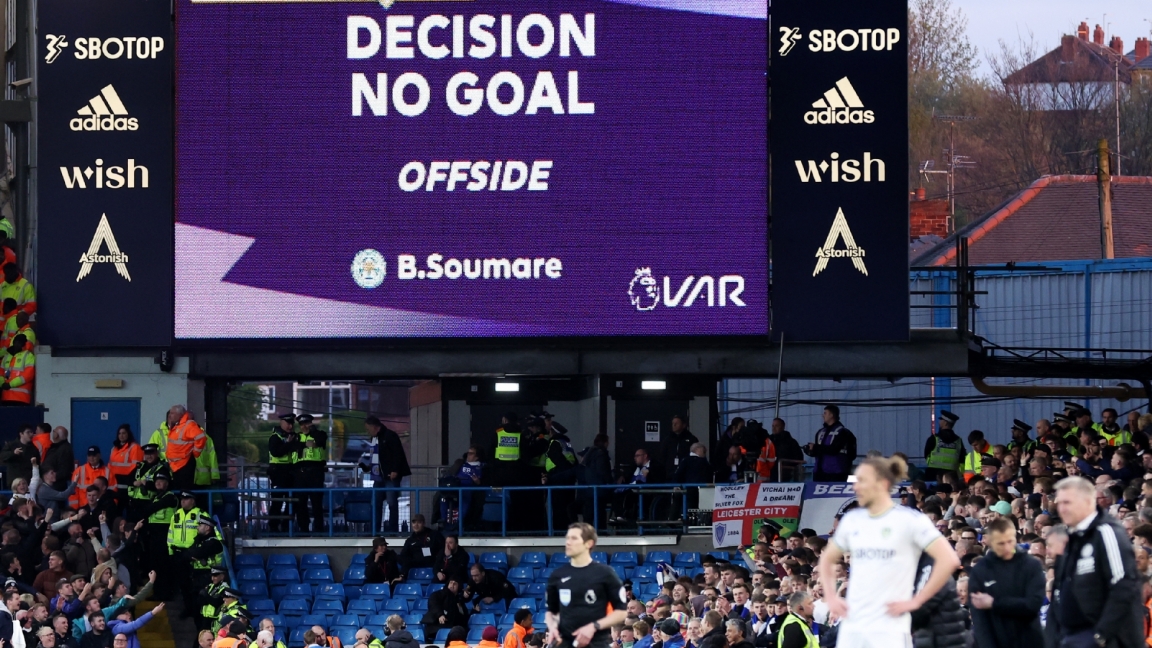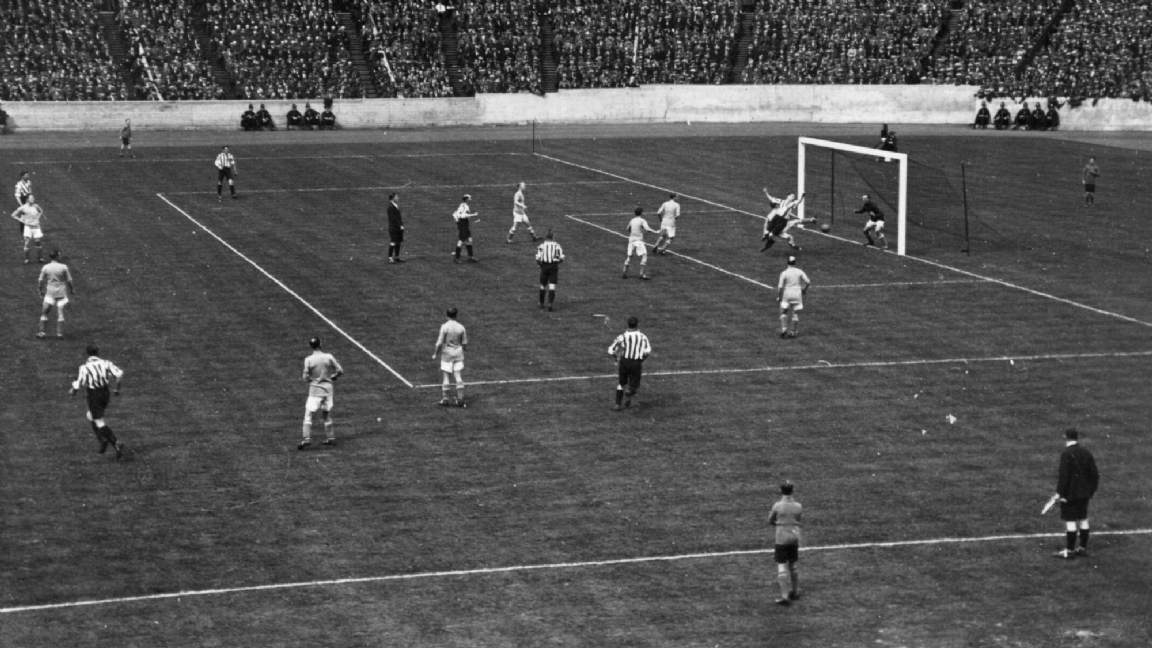![]()


From total football to anti-football and everything in between. Winning the coveted three points has come in all shapes and sizes since time immemorial. In the Style Figures section, Voetbalzone goes along the fields of yesteryear to take a closer look at fabulous formations and special player roles. In this edition: the offside trap, how the most far-reaching rule in sport always balances between essential and superfluous.
By Kevin van Buuren
Problems in the football paradise. Marco van Basten, once a royal within the lines, wants to change the football laws again. When he sees Kylian Mbappé’s Champions League goal against Bayern Munich disallowed for offside on Valentine’s Day 2023, he questions his love for current football. “So often offside is given on a toe. You can also change the rule.” Van Basten has been lobbying FIFA since 2016 to change or abolish offside. In that year he is appointed to the football organization Chief Officer for Technical Development.
Kylian Mbappé’s equalizer against Bayern Munich was ruled out by the tiniest of margins ?? pic.twitter.com/NV9s1EMvl9
— ESPN FC (@ESPNFC) February 14, 2023
The fact that the former striker of Ajax and AC Milan, among others, receives mountains of criticism in that position does not affect him much. As a technical developer of football, he mainly wants to ’cause dust’ with his statements, he explains in 2017 to the General Journal. “The offside rule will not be abolished in the short term. But before it is brushed off, do some research.” San Marco expect football to adapt itself, with refreshing tactics. Although he leaves the position after two years, the contemporary analyst has not yet given up on his football revolution.
Debatable goal
Like the deep striker and his defender, the footballing world is never completely aligned when it comes to offside. In 2021, it is also a goal from France’s Mbappé that sparked discussion. In the final of the Nations League between Spain and France (1-2), the attacker (on the still camera image) is clearly offside with a through ball from Theo Hernández. Sliding defender Eric García’s little toe changes the trajectory of the ball only minimally, allowing Mbappé to check and finish. Referee Anthony Taylor still approved the goal, to everyone’s surprise. “Maybe he wants to go home early,” commentator Sierd de Vos speculates. Football International concludes, however, that Taylor applied the rules excellently. The deliberate play of the ball by García, however minimal, created a new situation: a valid goal.
This amendment of the law was intended to relax the offside rule somewhat. A refreshing idea, especially in the VAR era of sidelined arm cavities, but the judiciary IFAB (International Football Association Board) gives the unions new instructions before the competition starts after the summer tournament. From now on ‘consciously playing the ball’ is accompanied by ‘controlling the ball’. Future goals scored in a similar fashion to Spain-France will be disallowed following precedent García VS Mbappé. It’s a new chapter in either refining or screwing up the offside rule. The eternal discussion makes you long for simpler times, when the strange law only caused a stir when someone was or was not behind the ball at the time of play.
The simplest game
In fact, it was once the only ‘offside rule’; don’t get behind the ball. Modern football became according to the FIFA document The Laws of the Game first formed in 1863 with a set of official rules. Thanks to priest and headmaster John Charles Thring. Researcher Malcolm Tozer describes in his Breakthrougharticle Who invented football that as a schoolboy, Thring was part of the rough first draft of football. A game that was approached in different ways at different schools. The unstructured sport was played with hands and feet and the matches were no fun. Because each school had its own rules, the activity more often resulted in a debate about who was right.
Thring tried to set up a club with official rules with fellow football enthusiasts. However, due to opposition from the men who preferred tackling and playing with their hands, this failed. In 1862 Thring finally got its regulations, which were formulated under n

Write a note with this photo
aam of The Simplest Game. Although these inventors would also find that ‘simple football is the most difficult’. An official variant soon appeared: the Cambridge University Football Rules, in which hands were still possible, nevertheless only to stop an oncoming ball. In 1863 formed the first Football Association (FA) the final rules, in which hands and tackling were considered fouls. Both football and rugby were sports from then on.



Who could have envisioned this vision of the future when they came up with the offside rule?
The decline of football
Despite this, the sports still somewhat resembled each other. Offside was acknowledged Law Six: “When a player kicks the ball, anyone who is closer to the opponent’s goal line stands out of play.” Football was rugby without hands and violence. The ball may only be played wide or back. This made the sport a dribbling game. Just like in rugby, one player charged with the ball towards the opponent. His fellow players walked close by, not to offer themselves for a pass, but often to catch a possible loss of possession and try the same solo.
That did not change then in 1866 Law Six was changed. The forward pass, seen infrequently or not, was introduced. However, at the time of play, three players of the opposing team had to stand between the goal and the passed player. The goalkeeper and two defenders. Only, at a time when teams usually only fielded one or two defenders, and hardly anyone played a ball, the rule was hardly noticed. Yet the foundations of football stood, and the sport grew rapidly in these years. In Scotland, however, they viewed it differently. There, the footballer was sidelined from 1967 if “he was behind the second to last man” and “in the last fifteen yards of the field’. That had a major reason: they visited Scotland the passing gameinstead of endless dribbling.


At the beginning of the 20th century, football was gaining serious spectator numbers.
The first part of that rule was implemented by the FA in 1925, the first notion of modern offside. The change in 1925 was to avoid boring matches. Jonathan Wilson writes in History of Football Tactics about Newcastle’s offside trap, which drew goalless six times as a result. That season, the average number of goals per game was 2.58. Moderate numbers, given the 1-2-7 formations at the time. Before the sport suffocated and died of boredom, the FA stepped in. The association experimented with the Scottish rule, and a line 40 yards of the goal within which the attacker could not be offside. It became option one. The offside trap had to contain a risk. Visualize the old ‘three-man rule’: a player steps to force offside, but does not time well, then there is still that extra defender behind to catch the ball. From then on, a misstep would be crucial and lead to a striker running only at the keeper.
Then, as Van Basten also expects from his rigorous adaptation, the game developed on its own. Leaving aside some tactical development, this rule became the archetypal English kick and rush born. Because a striker could now be close to the last defender, the ball could also be moved there more quickly. According to romantic Willy Meisl, brother of national coach Hugo, the offside rule was even ‘the fall of sin of football’: “Where innocence was lost and commercialization won.” In particular, the emphasis on winning, instead of beauty and skill, would mean the downfall of the sport. Nevertheless, the development proved that Van Basten was right today. The game transforms according to its rules.


In 1925 you could still be sidelined by two defenders.
In 1990, FIFA further tightened the offside rule: an attacker may line up with the defender to onside to stay. In 2005, the footballer was even allowed to be partly offside, albeit with a body part that is not allowed to score, such as the arms. After numerous wrongly approved goals and technological developments, VAR came to make the game fairer. Human errors are removed from the game as much as possible, does it make it more fun? As Meisl wrote, the importance of profit sometimes takes precedence over the beauty of the game, when brilliant goals are rejected down to the millimetre. The Austrian predicted that the rule would be the downfall of the sport. Has that moment arrived? And is that radical Van Basten right after all and is it time to let the sport evolve before it succumbs to its own rules?
